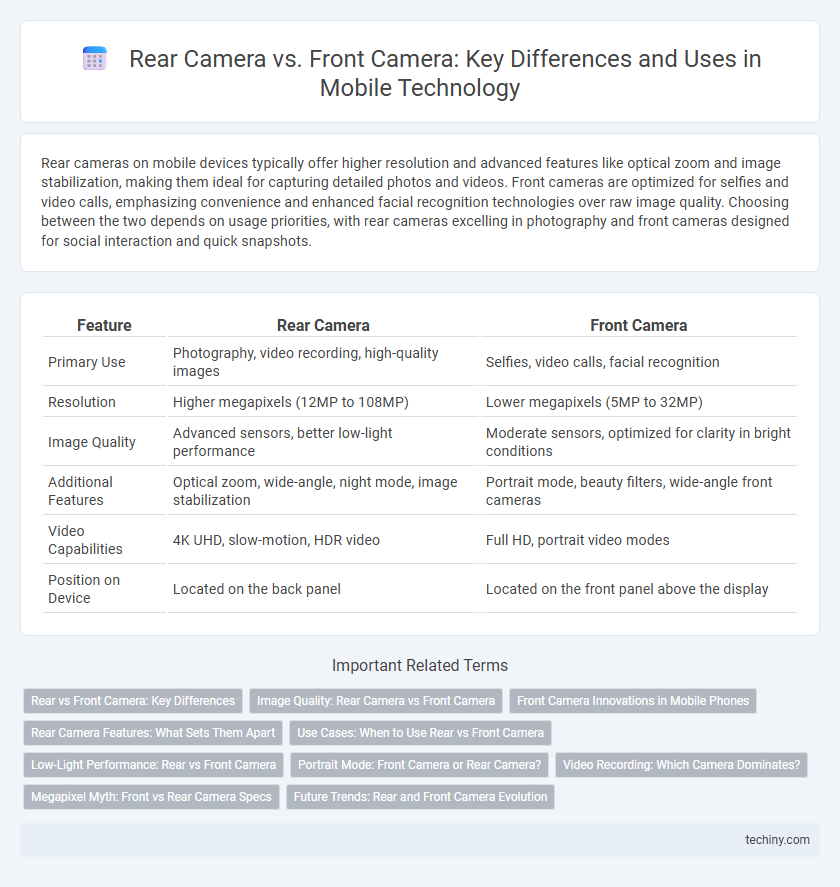Rear cameras on mobile devices typically offer higher resolution and advanced features like optical zoom and image stabilization, making them ideal for capturing detailed photos and videos. Front cameras are optimized for selfies and video calls, emphasizing convenience and enhanced facial recognition technologies over raw image quality. Choosing between the two depends on usage priorities, with rear cameras excelling in photography and front cameras designed for social interaction and quick snapshots.
Table of Comparison
| Feature | Rear Camera | Front Camera |
|---|---|---|
| Primary Use | Photography, video recording, high-quality images | Selfies, video calls, facial recognition |
| Resolution | Higher megapixels (12MP to 108MP) | Lower megapixels (5MP to 32MP) |
| Image Quality | Advanced sensors, better low-light performance | Moderate sensors, optimized for clarity in bright conditions |
| Additional Features | Optical zoom, wide-angle, night mode, image stabilization | Portrait mode, beauty filters, wide-angle front cameras |
| Video Capabilities | 4K UHD, slow-motion, HDR video | Full HD, portrait video modes |
| Position on Device | Located on the back panel | Located on the front panel above the display |
Rear vs Front Camera: Key Differences
The rear camera typically features higher megapixels, advanced sensors, and enhanced optical image stabilization, making it ideal for capturing detailed, high-quality photos and videos. The front camera prioritizes features like wider-angle lenses and software enhancements such as beauty modes and portrait effects to optimize selfies and video calls. Understanding these key differences helps users choose the right camera based on usage scenarios, whether for professional photography or casual self-portraits.
Image Quality: Rear Camera vs Front Camera
Rear cameras typically deliver superior image quality compared to front cameras due to larger sensors, higher megapixel counts, and advanced optical image stabilization. These technical advantages enable sharper details, better low-light performance, and more accurate color reproduction in rear camera photos. Front cameras, optimized for selfies and video calls, generally prioritize convenience over resolution, resulting in lower overall image quality.
Front Camera Innovations in Mobile Phones
Front camera innovations in mobile phones have revolutionized selfie quality by integrating higher megapixel sensors, advanced AI-powered beauty modes, and enhanced low-light performance. Technologies such as under-display cameras and ultra-wide lenses expand creative possibilities, while real-time facial recognition improves security features. These advancements cater to social media trends and video conferencing demands, making front cameras a crucial component in modern smartphones.
Rear Camera Features: What Sets Them Apart
Rear cameras in mobile technology typically boast higher megapixel counts, advanced sensor sizes, and superior image stabilization systems compared to front cameras, enabling enhanced photo quality and low-light performance. Features such as optical zoom, multiple lenses including ultra-wide and telephoto, and higher video resolution capabilities distinguish rear cameras for versatile photography. Integration of technologies like night mode, AI scene detection, and laser autofocus further elevate rear camera functionality, making them essential for professional-grade imaging on smartphones.
Use Cases: When to Use Rear vs Front Camera
Rear cameras excel in capturing high-resolution photos and videos, making them ideal for outdoor photography, landscapes, and detailed close-ups. Front cameras are optimized for selfies, video calls, and live streaming, providing convenience and real-time interaction with facial recognition features. Choosing between rear and front cameras depends on use cases prioritizing image quality or user engagement.
Low-Light Performance: Rear vs Front Camera
Rear cameras typically outperform front cameras in low-light conditions due to larger sensors and advanced image processing technologies. Higher pixel size and wider apertures in rear cameras capture more light, resulting in clearer and brighter images. Front cameras often rely on software enhancements and screen flash, which may not deliver the same quality in dim environments.
Portrait Mode: Front Camera or Rear Camera?
Rear cameras typically offer superior portrait mode capabilities due to larger sensors, advanced depth mapping, and better optical image stabilization, resulting in sharper images with enhanced background blur. Front cameras, while improving with AI-driven software enhancements and multiple lenses, generally have smaller sensors limiting low-light performance and depth accuracy. Choosing rear cameras for portrait mode maximizes image quality and detail, benefiting from hardware optimized for capturing detailed, professional-like portraits.
Video Recording: Which Camera Dominates?
Rear cameras dominate video recording with higher resolution sensors, advanced stabilization features, and superior lens quality, enabling crisp, professional-quality footage. Front cameras primarily cater to video calls and selfies, offering moderate resolution and basic stabilization, limiting their effectiveness for high-end video production. Recent advancements in rear-camera technology, including 4K and even 8K video capture, emphasize their clear advantage over front-facing cameras in video recording performance.
Megapixel Myth: Front vs Rear Camera Specs
Rear cameras typically feature higher megapixel counts, often ranging from 12MP to 108MP, designed to capture detailed, high-resolution images and support advanced features like optical zoom and image stabilization. Front cameras generally have lower megapixels, around 8MP to 32MP, optimized for wide-angle selfies and video calls with enhanced software processing for better portrait effects. The megapixel count alone does not determine image quality; sensor size, aperture, and image processing algorithms play crucial roles in both front and rear camera performance.
Future Trends: Rear and Front Camera Evolution
Future trends in mobile technology indicate significant advancements in both rear and front camera systems, with rear cameras evolving towards higher resolution sensors, multi-lens arrays, and AI-powered image processing for enhanced photography and augmented reality applications. Front cameras are expected to incorporate improved under-display technology, higher pixel density, and advanced facial recognition capabilities, enabling seamless video calls and biometric security. Integration of 3D depth sensing and computational photography will further blur the lines between rear and front camera functionalities, offering versatile imaging solutions for users.
Rear Camera vs Front Camera Infographic

 techiny.com
techiny.com